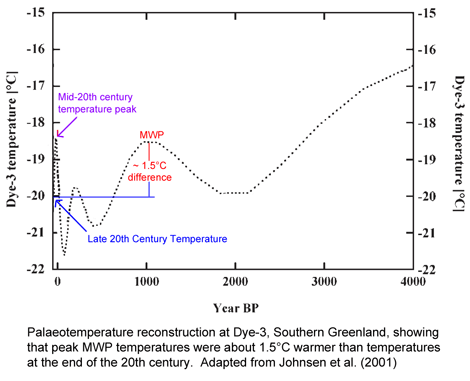Dye-3, Southern Greenland
Reference
Johnsen, S.J., Dahl-Jensen, D., Gundestrup, N., Steffensen, J.P., Clausen, H.B., Miller, H., Masson-Delmotte, V., Sveinbjörnsdottir, A.E. and White, J. 2001. Oxygen isotope and palaeotemperature records from six Greenland ice-core stations: Camp Century, Dye-3, GRIP, GISP2, Renland and NorthGRIP. Journal of Quaternary Science 16: 299-307.
Reference
Johnsen, S.J., Dahl-Jensen, D., Gundestrup, N., Steffensen, J.P., Clausen, H.B., Miller, H., Masson-Delmotte, V., Sveinbjörnsdottir, A.E. and White, J. 2001. Oxygen isotope and palaeotemperature records from six Greenland ice-core stations: Camp Century, Dye-3, GRIP, GISP2, Renland and NorthGRIP. Journal of Quaternary Science 16: 299-307.
Description
Palaeotemperature estimates were obtained by Monte Carlo inversion techniques from a Dye-3 (65.19°N, 49.83°W) borehole temperature profile of the southern portion of the Greenland Ice Cap. From the results plotted in the authors' Figure 6, it can be seen that temperatures during the Medieval Warm Period peaked and hovered around -18.5°C for three centuries between ~AD 800 to 1100. Temperatures of the Current Warm Period also peaked at around the same temperature, but only for a few short decades in the early 1900s. Presently, temperatures based upon this method are about 1.5°C colder than the peak warmth of Medieval Times.





